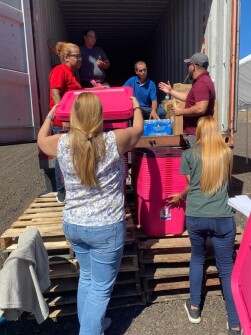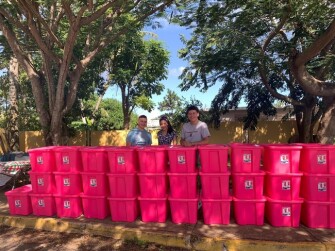
“Again,” Isabel Rodriguez Santos said. Then she sighed.
The veteran teacher in Puerto Rico was thinking about how she’s felt the strong earthquakes that have hit the southern end of the island hardest and (among other disruptive and damaging consequences) closed public schools since Jan. 8. It’s similar to her emotions during and in the aftermath of Hurricane Maria in 2017, which devastated the island and upended the schools there. But this time, there’s one unsettling difference.
“It’s more difficult than Maria. We knew the hurricane would pass over the island,” whereas people don’t know when the earthquakes will stop, she said. In fact, Rodriguez Santos, who teaches at Maria Cadilla High School in Arecibo and who we profiled shortly after Maria, said this uncertainty has led her to feel scared like she never has before.
Arecibo is on the northern side of the island, but Rodriguez Santos and her family were in Ponce on the U.S. territory’s south side visiting her in-laws in early January, a few days after powerful earthquakes began striking the region. Since then, she’s brought food and other supplies to people in the Ponce area who have left their homes and are living under improvised shelters in the streets. One such shelter she visited was being used by a woman who’s eight months pregnant, Rodriguez Santos noted.
She and some of her students at Maria Cadilla (where she teaches marketing) as well as others in her community have been organizing donations to deliver to Utuado, which is in the center of the island, as well as to Ponce. That’s been made easier to facilitate because, unlike in the aftermath of Hurricane Maria, she’s able to use her phone to communicate with students easily.

“They’re scared. They’re scared it’s going to happen again,” Rodriguez Santos said, referring to earthquakes.
All of the donations she’s dealt with so far, she said, have been from fellow Puerto Ricans. One thing that displaced families need in particular is plastic storage for their belongings to prevent them from being damaged if families are removed from their homes.
See Our In-Depth Coverage: Putting Puerto Rico’s 69��ý Back on Track
The Puerto Rican government that of the 561 schools that had been inspected for earthquake damage—about two-thirds of all public schools on the island—326 were deemed eligible to open. But while some schools are expected to open again this coming week, it’s not clear how many will remain shut down due to potential or actual damage from the earthquakes, or if some of the schools might remain closed for weeks or months. Making matters worse: a recent inspection found that .
Rodriguez Santos said she doesn’t know the condition of her school or when it will reopen. She also said it’s possible that when schools do reopen, some of them will need to use trailers to accommodate students.
“This is a very difficult time in Puerto Rico. But our students are on the streets, helping others,” she told me. “We are teaching them how to be strong.”
Photos from top: Residents of Arecibo organize donations to be delivered to Utuado and Ponce following several severe earthquakes in Puerto Rico; students at Maria Cadilla High School in Arecibo, Puerto Rico organized donations for those affected by recent earthquakes on the southern side of the island. (Photos courtesy of Isabel Rodriguez Santos)
